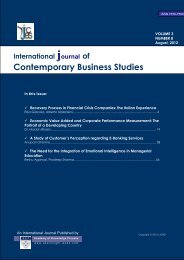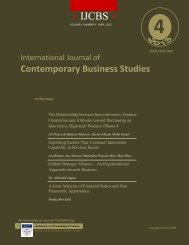Contemporary Business Studies - Academy of Knowledge Process ...
Contemporary Business Studies - Academy of Knowledge Process ...
Contemporary Business Studies - Academy of Knowledge Process ...
You also want an ePaper? Increase the reach of your titles
YUMPU automatically turns print PDFs into web optimized ePapers that Google loves.
International Journal <strong>of</strong> <strong>Contemporary</strong> <strong>Business</strong> <strong>Studies</strong><br />
Vol: 3, No: 1. January, 2012 ISSN 2156-7506<br />
Available online at http://www.akpinsight.webs.com<br />
expressed as a numerical score given as a result <strong>of</strong> applying the model and measures. The higher the risk<br />
pr<strong>of</strong>ile score, the higher the supplier’s disruption potential to the supply chain. In order to apply the risk<br />
results to potential events, the survey results were reorganized into operational, network and external riskrelated<br />
measures, and the results were recalculated for each supplier. The reorganized measures are<br />
presented in Appendix 1. The financial impact <strong>of</strong> the risk pr<strong>of</strong>iles on company revenues was calculated<br />
by identifying the components furnished by individual suppliers, associating those components with a<br />
finished product and product gross revenue, and computing the sum <strong>of</strong> associated monthly revenues for<br />
each supplier.<br />
4.3Sample and Data Collection<br />
The study sample consists <strong>of</strong> five automotive casting suppliers to a major automotive company in the<br />
United States. The sample data was collected by first interviewing the supplier’s account representative to<br />
discuss the study and the internet-based survey. Subsequently, the survey instrument web link was sent in<br />
an email to the supplier’s account representative. The account representative completed the survey,<br />
supplier historical performance data was evaluated, and a company analyst conducted an environmental<br />
analysis <strong>of</strong> the organization. All risk ratings were assessed using a five-point Likert scale and a risk index<br />
was calculated for each supplier. In addition, each supplier provided a-priori probabilities for the twelve<br />
risk events identified in Appendix 1. The a-priori probabilities were determined via a review <strong>of</strong> relevant<br />
quantitative and qualitative information by a team <strong>of</strong> company personnel familiar with the identified risk<br />
events as they relate to the five suppliers. By logically examining the information, the team was able to<br />
estimate a-priori probability values pertaining to the twelve risk events for each supplier. These<br />
probabilities provided the basis for the construction <strong>of</strong> Bayesian networks used in the creation <strong>of</strong> the<br />
supplier risk pr<strong>of</strong>iles.<br />
4.4Research Model<br />
Bayesian networks were constructed to examine the probability <strong>of</strong> a supplier’s impact on company<br />
revenues.Network, operational, and external risk levels were computed using the provided a-priori<br />
probabilities for the identified risk events. These risk levels were then used to determine a supplier’s<br />
probability <strong>of</strong> revenue impact on the company. A diagram <strong>of</strong> the Bayesian networks used in this study is<br />
illustrated in Figure 2.<br />
Network Key<br />
1 = Misalignment <strong>of</strong> interest<br />
2 = Supplier Financial Stress<br />
3 = Supplier Leadership Change<br />
4 = Tier 2 Stoppage<br />
5 = Supplier Network Misalignment<br />
6 = Quality Problems<br />
7 = Delivery Problems<br />
8 = Service Problems<br />
9 = Supplier HR Problems<br />
10 = Supplier Locked<br />
11 = Merger/Divestiture<br />
12 = Disasters<br />
Figure 2. Supplier Bayesian Network<br />
12<br />
Copyright © 2012. <strong>Academy</strong> <strong>of</strong> <strong>Knowledge</strong> <strong>Process</strong>
















